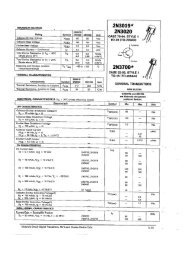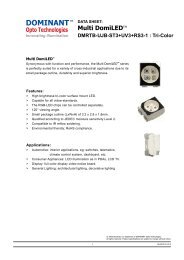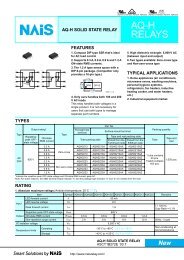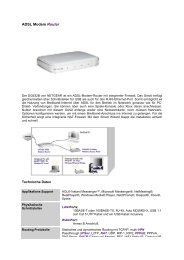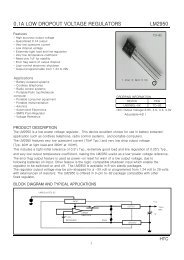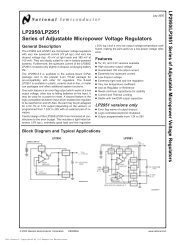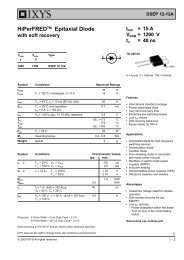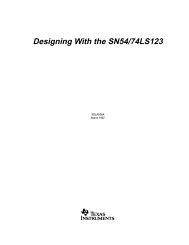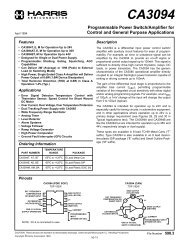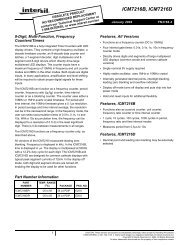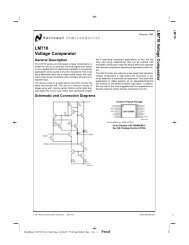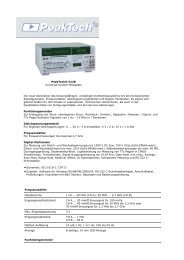LT3080 - Adjustable 1.1A Single Resistor Low Dropout Regulator
LT3080 - Adjustable 1.1A Single Resistor Low Dropout Regulator
LT3080 - Adjustable 1.1A Single Resistor Low Dropout Regulator
You also want an ePaper? Increase the reach of your titles
YUMPU automatically turns print PDFs into web optimized ePapers that Google loves.
<strong>LT3080</strong><br />
BLOCK DIAGRA W<br />
APPLICATIO S I FOR ATIO<br />
8<br />
U W U U<br />
The <strong>LT3080</strong> regulator is easy to use and has all the protection<br />
features expected in high performance regulators.<br />
Included are short-circuit protection and safe operating<br />
area protection, as well as thermal shutdown.<br />
The <strong>LT3080</strong> is especially well suited to applications needing<br />
multiple rails. The new architecture adjusts down to zero<br />
with a single resistor handling modern low voltage digital<br />
IC’s as well as allowing easy parallel operation and thermal<br />
management without heat sinks. Adjusting to “zero” output<br />
allows shutting off the powered circuitry and when the<br />
input is pre-regulated – such as a 5V or 3.3V input supply<br />
– external resistors can help spread the heat.<br />
A precision “0” TC 10μA internal current source is connected<br />
to the non-inverting input of a power operational<br />
amplifi er. The power operational amplifi er provides a low<br />
impedance buffered output to the voltage on the non-inverting<br />
input. A single resistor from the non-inverting input to<br />
ground sets the output voltage and if this resistor is set<br />
to zero, zero output results. As can be seen, any output<br />
voltage can be obtained from zero up to the maximum<br />
defi ned by the input power supply.<br />
What is not so obvious from this architecture are the benefi<br />
ts of using a true internal current source as the reference<br />
as opposed to a bootstrapped reference in older regulators.<br />
A true current source allows the regulator to have gain<br />
and frequency response independent of the impedance on<br />
the positive input. Older adjustable regulators, such as the<br />
IN<br />
V CONTROL<br />
SET<br />
10μA<br />
+<br />
–<br />
3080 BD<br />
OUT<br />
LT1086 have a change in loop gain with output voltage<br />
as well as bandwidth changes when the adjustment pin<br />
is bypassed to ground. For the <strong>LT3080</strong>, the loop gain is<br />
unchanged by changing the output voltage or bypassing.<br />
Output regulation is not fi xed at a percentage of the output<br />
voltage but is a fi xed fraction of millivolts. Use of a true<br />
current source allows all the gain in the buffer amplifi er<br />
to provide regulation and none of that gain is needed to<br />
amplify up the reference to a higher output voltage.<br />
The <strong>LT3080</strong> has the collector of the output transistor<br />
connected to a separate pin from the control input. Since<br />
the dropout on the collector (IN pin) is only 300mV, two<br />
supplies can be used to power the <strong>LT3080</strong> to reduce dissipation:<br />
a higher voltage supply for the control circuitry<br />
and a lower voltage supply for the collector. This increases<br />
effi ciency and reduces dissipation. To further spread the<br />
heat, a resistor can be inserted in series with the collector<br />
to move some of the heat out of the IC and spread it on<br />
the PC board.<br />
The <strong>LT3080</strong> can be operated in two modes. Three terminal<br />
mode has the control pin connected to the power input pin<br />
which gives a limitation of 1.35V dropout. Alternatively,<br />
the “control” pin can be tied to a higher voltage and the<br />
power IN pin to a lower voltage giving 300mV dropout<br />
on the IN pin and minimizing the power dissipation. This<br />
allows for a <strong>1.1A</strong> supply regulating from 2.5VIN to 1.8VOUT<br />
or 1.8VIN to 1.2VOUT with low dissipation.<br />
3080f



